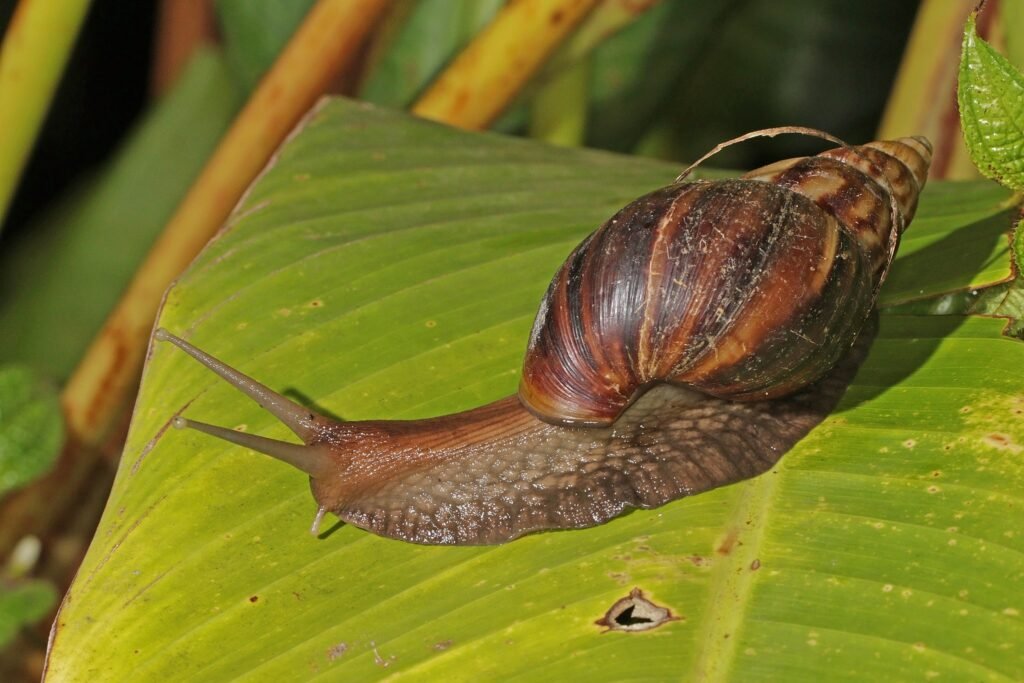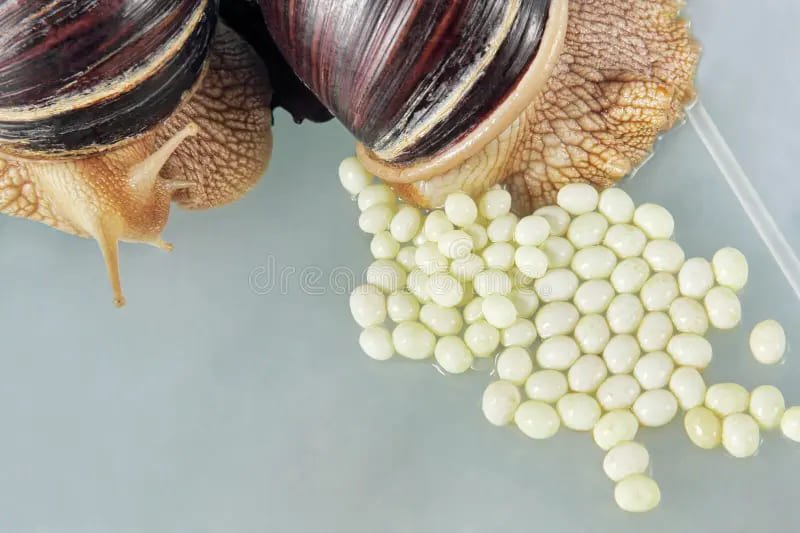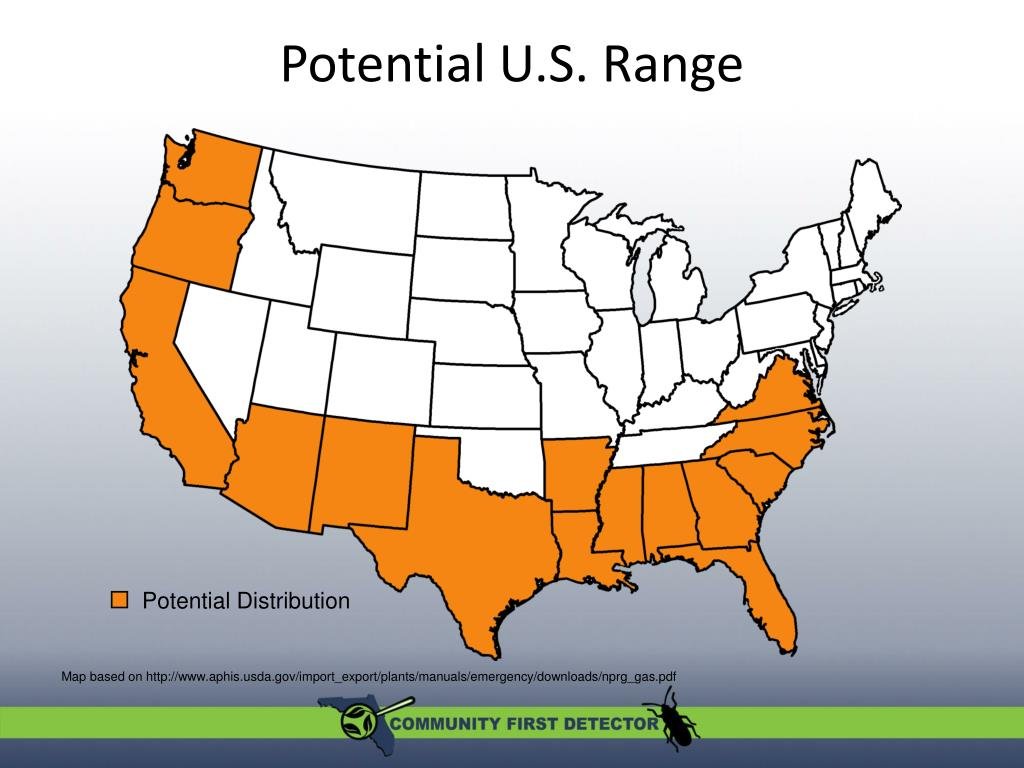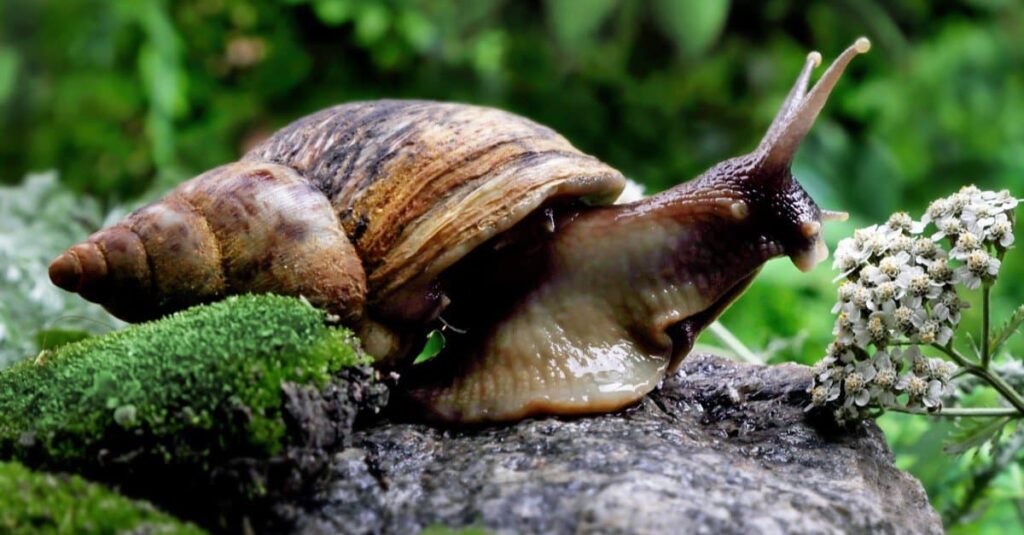Last updated on May 12, 2025
If you’ve ever wondered just how quickly Giant African snails can multiply, the answer might shock you! These invasive creatures are prolific breeders, laying hundreds of eggs at a time and rapidly increasing their population. This rapid reproduction is one of the key reasons they are considered a major agricultural and ecological threat in many regions.
The Giant African Snail (Lissachatina fulica) is one of the world’s most notorious invasive species. Originally from East Africa, this large land snail has spread across multiple continents, causing significant damage to agriculture, native ecosystems, and even human health. Its ability to reproduce rapidly and consume a vast range of plant species makes it a formidable threat in non-native environments.
This guide answers the most frequently asked questions about the Giant African Snail, covering its habitat, diet, reproductive behaviors, potential dangers, and control measures. Whether you’re a concerned homeowner, researcher, or policymaker, understanding this species is essential for preventing its spread and mitigating its impact.
What Are Giant African Snails?
The Giant African Snail (Lissachatina fulica) is one of the most invasive terrestrial mollusks, originally native to East Africa but now found in tropical and subtropical regions worldwide. These snails are known for their rapid reproduction, adaptability, and ability to consume a wide range of plants, which makes them a significant ecological and agricultural threat.
Why Is Their Reproduction Rate Important?
Giant African snails are hermaphrodites, meaning they have both male and female reproductive organs. This unique trait allows them to mate with any other individual of their species, dramatically increasing their ability to reproduce. A single snail can lay hundreds of eggs per clutch and produce thousands of offspring within a year under favorable conditions.
Key Concerns Related to Their Reproduction:
- Agricultural Damage: They feed on over 500 plant species, including key crops like bananas, cassava, and cocoa.
- Ecological Impact: These snails outcompete native species, altering biodiversity and threatening ecosystems.
- Human Health Risks: Giant African snails can carry Angiostrongylus cantonensis (rat lungworm), a parasite that may cause meningitis in humans.
The Need for Controlling Their Population
Given their high reproductive capacity, these snails are difficult to manage once they establish themselves in an area. Understanding the factors that influence their breeding cycle and their population growth is essential for implementing effective control measures to prevent environmental and economic damage.
Giant African Snail Description

Physical Characteristics
The Giant African Snail (Lissachatina fulica) is one of the largest terrestrial snails, reaching up to 8 inches (20 cm) in length and 4 inches (10 cm) in diameter. They have distinctive conical shells with brownish bands, though coloration may vary depending on environmental factors and diet. Their soft bodies are light to dark brown, and they produce mucus to aid in movement and moisture retention.
Native Habitat and Distribution
Originally native to East Africa, particularly Kenya and Tanzania, the Giant African Snail has spread to Asia, the Pacific Islands, South America, and parts of the United States, primarily through accidental human transport. They thrive in tropical and subtropical climates, preferring moist, humid environments such as forests, gardens, and agricultural fields. Due to their adaptability, they have become a serious invasive species, causing environmental and economic damage in many regions.
Ecological and Agricultural Impact
These snails are voracious herbivores, consuming over 500 plant species, including essential food crops like bananas, cassava, and cocoa. Their feeding habits result in:
- Crop devastation, leading to significant economic losses for farmers.
- Displacement of native species, disrupting local ecosystems.
- Soil degradation, as their feeding and burrowing alter nutrient cycles.
Additionally, Giant African Snails are known carriers of parasites like Angiostrongylus cantonensis (rat lungworm), which poses a health risk to humans. Due to their rapid reproduction and ability to thrive in diverse environments, controlling their spread remains a major challenge worldwide.
Giant African Snail Life Cycle
Understanding the life cycle of the Giant African Snail (Lissachatina fulica) is crucial for effective management and control strategies. These snails reproduce rapidly and adapt well to various environments, making them a significant invasive species.
Stages from Egg to Maturity
1. Egg Stage
- Mating and Egg Laying: These snails are hermaphroditic, meaning they possess both male and female reproductive organs. While self-fertilization is possible, they typically prefer to mate with another snail. After mating, each snail can lay between 100 to 500 eggs in a single clutch (NY Invasive Species).
- Egg Characteristics: The eggs are small, white, and spherical, usually deposited in moist soil, under leaf litter, or in hidden crevices to maintain humidity.
2. Hatchling Stage
- Hatching Period: Eggs hatch within 11 to 15 days, depending on environmental conditions such as temperature and humidity (Ministry of Agriculture).
- Characteristics of Hatchlings: Newly hatched snails are approximately 4 mm in length. Their shells are soft and translucent, making them highly vulnerable to predators and environmental stressors.
3. Juvenile Stage
- Growth and Development: During this phase, snails experience rapid growth. They undergo three juvenile stages (J1, J2, J3) before reaching maturity. The total development from egg to adult spans 150 to 160 days (Solutions For Life).
- Diet: Juveniles feed on a variety of plant materials, including decaying leaves, fruits, and crops, which are essential for their shell development and overall growth.
5. Adult Stage
- Maturity: Snails reach sexual maturity at approximately 6 months of age. At this stage, they can begin reproducing.
- Reproduction: Adults can lay multiple clutches of eggs annually, significantly increasing their population density in a short period.
- Lifespan: In the wild, these snails typically live for 3 to 5 years, but under optimal conditions, they can survive up to 10 years.
Timeframe for Each Developmental Stage
- Egg Stage: 11 to 15 days for hatching.
- Juvenile Stage: 150 to 160 days to reach adulthood.
- Adult Stage: Sexual maturity is achieved around 6 months, with a potential lifespan extending up to 10 years in captivity.
Due to their fast reproductive rate and adaptability, Giant African Snails are challenging to control. Understanding their life cycle is essential for implementing effective prevention and eradication measures.
How Rapidly Do Giant African Snails Reproduce?
Understanding the reproductive dynamics of the Giant African Snail (Lissachatina fulica) is crucial for managing and controlling their population. These snails reproduce at an alarming rate, contributing to their invasive nature in many regions.
Age of Sexual Maturity
- Reproductive Readiness: Giant African Snails are hermaphroditic, meaning each individual has both male and female reproductive organs. While self-fertilization is possible, they typically mate with another snail.
- Time to Maturity: They reach sexual maturity within 5 to 6 months, depending on environmental conditions such as temperature and food availability (ResearchGate).
Frequency and Size of Egg Clutches
- Clutch Size: Each reproductive cycle produces 100 to 500 eggs per clutch (Animal Diversity Web).
- Egg Laying Frequency: Under favorable conditions, a mature snail can lay 5 to 6 clutches annually, approximately every 2 to 3 months.
- Egg Development: The eggs, which are small and white, hatch within 11 to 15 days, leading to a rapid increase in snail populations (Ministry of Agriculture).
Annual Reproductive Potential
- Egg Production Per Year: A single Giant African Snail can produce 500 to 3,000 eggs annually.
- Survival Rate: Not all eggs hatch or reach maturity due to predation, environmental factors, and resource competition. However, even a fraction of these eggs developing into adults can lead to exponential population growth.
Due to their rapid reproduction and adaptability, Giant African Snails pose a significant threat to agriculture, ecosystems, and urban environments. Effective control measures are necessary to mitigate their spread.

Reproductive Behaviors of the Giant African Snail
The Giant African Snail (Lissachatina fulica) exhibits unique reproductive behaviors that contribute to its rapid population growth and invasive potential.
Hermaphroditic Nature
These snails are hermaphrodites, possessing both male and female reproductive organs. While self-fertilization is possible, it is uncommon; they typically prefer to mate with another snail to exchange sperm (biokids.umich.edu).
Mating Behavior
- Courtship Rituals: Mating usually occurs at night and involves a courtship process where snails engage in tactile interactions (edis.ifas.ufl.edu).
- Mating Frequency: They can mate every two to three months, and a single mating session allows them to store sperm for up to two years, enabling multiple egg clutches without repeated mating (animaldiversity.org).
Egg Laying and Development
- Clutch Size: Each snail can lay between 100 to 500 eggs per clutch, with an average of 200 eggs.
- Egg Deposition: Eggs are typically laid 1–3 weeks after mating, but egg-laying can continue for more than a year.
- Hatching Period: Eggs hatch after 8 to 21 days, depending on environmental conditions.
Sexual Maturity
Giant African Snails reach sexual maturity around six months of age, at which point they can begin reproducing (animaldiversity.org).
Implications for Population Growth
High reproductive rates, sperm storage, and rapid maturity combine to increase the species’ invasiveness, making effective management crucial.
Understanding these reproductive behaviors is essential for developing strategies to control their populations and mitigate their impact on ecosystems.
Factors Influencing Reproduction Rate
Understanding the factors that influence the reproductive rate of the Giant African Snail (Lissachatina fulica) is essential for developing effective management strategies. Key factors include environmental conditions and the availability of resources.
Environmental Conditions
The reproductive success of Giant African Snails is closely linked to specific environmental parameters:
- Temperature: Optimal reproductive activity occurs in warm climates, particularly within the temperature range of 25°C to 30°C. These conditions promote mating behaviors and egg development (Cornous).
- Humidity: High humidity levels, typically above 80%, are favorable for reproduction. Elevated humidity supports egg viability and hatchling survival.
- Rainfall Patterns: In regions like New Guinea, Giant African Snails typically produce two clutches of eggs each year, corresponding to the start of rainy seasons (PMC).
- Microclimate Conditions: Urban habitat structures and weather variables significantly impact snail reproduction. Studies have shown that more gravid snails are collected when temperatures are higher, and more snails are collected in weeks with high humidity.
Conversely, suboptimal environmental conditions, such as low humidity or extreme temperatures, can lead to reduced reproductive rates or trigger aestivation—a state of dormancy that halts reproductive activities (ResearchGate).
Availability of Resources
Access to adequate resources directly affects the reproductive capacity of Giant African Snails:
- Food Quality and Quantity: A diet rich in nutrients enhances reproductive outcomes. Well-nourished snails grow larger and exhibit higher fertility rates. In contrast, limited or poor-quality food sources can lead to reduced growth and diminished reproductive capacity (Sci-Arch).
- Habitat Structure: Urban environments with diverse habitat structures provide microhabitats that can influence reproductive rates. The availability of shelter and suitable egg-laying sites within these habitats can impact reproductive success.
- Population Density: High-density conditions can lead to competition for resources, potentially reducing individual reproductive success. Conversely, low-density conditions may facilitate higher reproductive rates due to reduced competition (PMC).
Understanding these factors is crucial for implementing targeted control measures to manage the spread of this invasive species effectively.
How Was the Giant African Snail Introduced?
The Giant African Snail (Lissachatina fulica), native to East Africa, has spread to many regions worldwide, primarily through human activities and accidental transport. Understanding the pathways of its introduction and human contributions to its spread is crucial for effective management and prevention.
Pathways of Introduction to Non-Native Regions
The Giant African Snail has been introduced to non-native areas through several primary pathways:
- Accidental Transport: These snails often hitchhike on various commodities, including agricultural products, vehicles, shipping containers, pallets, and heavy equipment. This inadvertent movement facilitates their spread across borders.
- Intentional Introduction: In some cases, Giant African Snails have been smuggled into new regions for use as exotic pets, educational purposes, or even as a food source. Once released or escaped, they establish breeding populations that disrupt local ecosystems.
Human Activities Contributing to Their Spread
Human actions play a significant role in the global spread of the Giant African Snail:
- Pet Trade: The exotic pet trade has led to the intentional importation of these snails. However, improper containment or deliberate release by pet owners has resulted in their establishment in non-native environments.
- Agricultural Practices: The movement of plants, soil, and agricultural products contaminated with snail eggs or juveniles has facilitated their spread. Infested nursery plants can introduce snails to new areas.
- Global Trade and Travel: The expansion of global trade and tourism has inadvertently transported these snails across continents. They can stow away in cargo shipments, luggage, or vehicles, leading to infestations in distant regions (nonnativespecies.org).
Recognizing these introduction pathways and human-mediated activities is crucial for implementing preventive measures to control the spread of the Giant African Snail.
How Did the Giant African Snail Get to America?
The Giant African Snail (Lissachatina fulica) has made its way to the Americas through various means, primarily due to human activities. Understanding the historical accounts of its introduction and the regions affected is crucial for effective management and prevention strategies.

Historical Accounts of Introduction
The introduction of the Giant African Snail to the Americas has been documented in several instances:
- Hawaii (1936): The snail was first introduced to Hawaii in 1936 (nyis.info).
- Florida (1966): In 1966, three Giant African Snails were illegally brought into Miami as pets. These snails were released into a garden, and within seven years, the population exploded to over 18,000 individuals. This infestation led to a costly eradication effort, amounting to $1 million (tsusinvasives.org).
- Florida (2011): After being eradicated, the snails were rediscovered in Miami in 2011, prompting renewed eradication efforts (usgs.gov).
- Florida (2022): Despite previous eradication efforts, the snails were found again in Florida in 2022 (en.wikipedia.org).
Regions in America Affected by Their Presence
The Giant African Snail has primarily affected the following regions in the Americas:
- Florida: The state has experienced multiple infestations, with significant populations detected in Miami and other southern regions. The warm and humid climate of Florida provides an ideal environment for the snails to thrive.
- Potential Spread to Other States: Climate modeling indicates that Giant African Snail populations could potentially survive in non-mountainous regions of several U.S. states, including Virginia, North Carolina, South Carolina, Georgia, Alabama, Mississippi, Louisiana, Arkansas, Texas, New Mexico, Arizona, California, and parts of Oregon and Washington (aphis.usda.gov).
The ability of these snails to adapt to various climates poses a significant threat to agriculture and natural ecosystems across these regions.
How Does the Giant African Snail Affect the Ecosystem?
The Giant African Snail (Lissachatina fulica) is an invasive species that poses serious threats to ecosystems, agriculture, and human health. Its rapid reproduction and voracious appetite make it a formidable pest in affected regions.
Impact on Native Flora and Fauna
- Destruction of Vegetation: The Giant African Snail feeds on over 500 plant species, including crops, ornamental plants, and native vegetation. This can lead to defoliation, loss of biodiversity, and habitat destruction.
- Threat to Native Species: The snail competes with native mollusks and other herbivorous species for food, leading to population declines and disruptions in local food chains.
- Alteration of Soil Composition: Their feeding and waste production contribute to changes in soil nutrient levels, potentially affecting plant growth and ecosystem stability.
Economic Implications for Agriculture
- Crop Damage: Giant African Snails consume a wide range of crops, including fruits, vegetables, and grains, leading to reduced agricultural yields and financial losses for farmers.
- Increased Management Costs: Farmers and agricultural agencies spend millions on eradication efforts, pesticides, and quarantine measures to control infestations.
- Trade Restrictions: Infestations can result in agricultural export bans, negatively impacting economies that rely on international trade.
Health Risks Associated with Their Proliferation
- Disease Transmission: The Giant African Snail is a known carrier of the rat lungworm parasite (Angiostrongylus cantonensis), which can cause eosinophilic meningitis in humans if ingested.
- Allergic Reactions: Contact with the snail’s mucus can trigger allergic reactions in some individuals, posing health concerns in heavily infested areas.
- Contaminated Water Sources: The presence of large snail populations can lead to contamination of water supplies, increasing the risk of disease transmission to humans and animals.
The spread of the Giant African Snail poses severe risks to biodiversity, food security, and public health. Efforts to control and prevent their spread are essential to protect ecosystems and economies from further damage.
Giant African Snail Habitat Preferences
The Giant African Snail (Lissachatina fulica) thrives in various environments, making it a highly adaptable species capable of surviving outside its native range. Understanding its habitat preferences is crucial for developing control strategies and mitigating its spread.
Ideal Environmental Conditions
Giant African Snails prefer warm, humid environments with abundant vegetation. Their ideal habitat includes:
- Temperature Range: Optimal growth occurs between 22°C and 32°C (71.6°F to 89.6°F) (mdpi.com).
- High Humidity: Moist conditions are essential for their survival, as dry environments lead to desiccation.
- Shaded and Sheltered Areas: The snails seek refuge in leaf litter, under rocks, and in dense vegetation to avoid excessive heat and dehydration.
- Soil Type: They prefer calcium-rich soils, which support shell development.
These conditions are commonly found in low- to mid-elevation tropical and subtropical regions, including rainforests, agricultural lands, and urban gardens.
Adaptability to Various Climates
Despite their preference for warm climates, Giant African Snails have demonstrated remarkable adaptability, enabling them to colonize new environments worldwide. They have been found in:
- Temperate Regions: Some populations have adapted to cooler temperatures, with reports of survival in conditions as low as 9°C (48.2°F) (animaldiversity.org).
- Urban and Agricultural Areas: Their presence in cities and farms indicates a high tolerance for human-modified landscapes.
- Dry Climates: During droughts or extreme heat, they enter a state of aestivation, sealing their shells to conserve moisture and survive unfavorable conditions.
Why Does This Matter?
The Giant African Snail’s ability to adapt to various climates increases its invasive potential, making eradication efforts challenging. Recognizing its habitat preferences allows for the development of targeted management strategies to limit its spread and minimize ecological and agricultural damage.
Giant African Snail Lifespan
The Giant African Snail (Lissachatina fulica) is renowned for its considerable size and adaptability. Understanding its lifespan in various environments and the factors influencing its longevity is essential for both pet owners and those involved in managing its populations.
Average Lifespan in the Wild and Captivity
- Wild Lifespan: Typically, these snails live between 3 to 5 years in their natural habitats. Predation and environmental challenges are primary factors influencing their survival (animaldiversity.org).
- Captive Lifespan: In controlled environments, with optimal care, they often live 5 to 7 years, with some individuals reaching up to 10 years (rvc.ac.uk).
Factors Affecting Longevity
Several elements can impact the lifespan of Giant African Snails:
- Environmental Conditions: They thrive in warm, humid climates. Exposure to extreme temperatures or prolonged dryness can reduce their lifespan.
- Diet and Nutrition: A balanced diet rich in calcium is crucial for shell health and overall vitality. Nutritional deficiencies can lead to health issues and decreased longevity.
- Predation and Disease: In the wild, predators and parasites pose significant threats. In captivity, maintaining cleanliness and monitoring for diseases are vital to prevent premature death.
- Stress Factors: Overcrowding, frequent handling, or inadequate habitat conditions can induce stress, adversely affecting their health and lifespan.
Why Is This Important?
Understanding the factors that influence the lifespan of Giant African Snails is crucial for effective management and conservation efforts. Whether in the wild or captivity, ensuring optimal environmental conditions and proper nutrition can significantly impact their longevity.
How to Prevent the Spread of Giant African Snails
Preventing the introduction and spread of Giant African Snails is crucial to protecting ecosystems, agriculture, and public health. Here are some effective prevention strategies:
1. Strengthen Biosecurity Measures
- Implement strict quarantine regulations for imported plants, soil, and agricultural products.
- Use sniffer dogs and inspections at ports of entry to detect hidden snails in shipments.
- Require permits and certifications for businesses handling live plants and organic materials.
2. Public Awareness and Education
- Educate farmers, gardeners, and the public on how to identify and report Giant African Snail sightings.
- Promote community clean-up events to remove potential snail habitats.
- Distribute information on the dangers of releasing exotic snails into the wild.
3. Proper Waste Management
- Dispose of food waste and plant debris properly to reduce food sources for snails.
- Secure compost piles with barriers to prevent snail infestations.
- Clean garden tools and boots after visiting infested areas to avoid spreading eggs.
4. Early Detection and Rapid Response
- Train local authorities and agricultural agencies to identify early infestations and respond quickly.
- Encourage citizens to report sightings through official hotlines or online platforms.
- Use GIS mapping and tracking systems to monitor and predict potential outbreaks.
5. Legislation and Enforcement
- Enforce strict penalties for illegal importation and possession of Giant African Snails.
- Develop international agreements for coordinated control and prevention efforts.
- Support research on new, eco-friendly eradication methods.
Management and Control Measures
The Giant African Snail (Lissachatina fulica) is considered one of the most invasive species globally, requiring effective management strategies to curb its spread. Authorities and researchers continue to develop and implement various control measures, with varying degrees of success.
Strategies to Curb Their Spread
Several approaches have been used to control Giant African Snail populations, including:
- Chemical Control: Molluscicides, such as metaldehyde and iron phosphate-based baits, are commonly used to eliminate snails. However, these must be carefully applied to minimize environmental harm (USDA APHIS).
- Biological Control: Some regions have experimented with introducing natural predators like predatory snails or parasitic nematodes, but this approach carries ecological risks if not carefully managed.
- Mechanical and Manual Removal: In highly affected areas, manual collection of snails has been an effective short-term strategy, often combined with community involvement.
- Regulatory Measures: Strict import controls and quarantine measures help prevent new introductions of Giant African Snails into unaffected regions.
- Public Awareness and Education: Informing the public about the risks associated with these snails and encouraging early detection are crucial in controlling their spread.
Success Stories and Ongoing Challenges
Success Stories
- Florida Eradication Efforts: Florida has successfully eradicated Giant African Snails twice, in the 1970s and again in 2021, using a combination of chemical treatments, manual collection, and public reporting campaigns (Florida Department of Agriculture and Consumer Services).
- Hawaii’s Integrated Control Methods: Hawaii has implemented a combination of mechanical removal and public education programs to limit the spread of the snails, with significant success in reducing their numbers in certain regions.
Ongoing Challenges
- Resurgence in Florida (2022-Present): Despite previous eradication success, new infestations were reported in Florida in 2022, demonstrating the species’ resilience and the need for continued monitoring.
- Resistance to Chemical Control: Some populations have shown signs of reduced susceptibility to certain molluscicides, necessitating the development of alternative control methods.
- Climate Change Impacts: Warmer temperatures and increased rainfall in some regions may create more favorable conditions for the Giant African Snail, complicating eradication efforts.
The Road Ahead
Managing the Giant African Snail requires a multifaceted approach, combining chemical, biological, and regulatory strategies. Ongoing research and international cooperation will be essential in preventing further spread and mitigating their impact on agriculture and native ecosystems.
Frequently Asked Questions About the Giant African Snail
1. What is the Giant African Snail?
The Giant African Snail (Lissachatina fulica) is a large, invasive land snail native to East Africa. It is considered one of the most destructive mollusks due to its rapid reproduction and ability to consume over 500 plant species.
2. Where is the Giant African Snail found?
This species has spread globally, thriving in tropical and subtropical regions. It is commonly found in Asia, the Pacific Islands, the Caribbean, and parts of the Americas due to human trade and accidental introductions.
3. Why is the Giant African Snail considered invasive?
It reproduces quickly, lacks natural predators in non-native areas, and competes with native species for food and habitat. It also damages crops and transmits diseases, making it a serious ecological and agricultural threat.
4. How does the Giant African Snail reproduce?
These snails are hermaphrodites, meaning they possess both male and female reproductive organs. They typically mate with other snails but can store sperm for up to two years. A single snail can lay hundreds of eggs multiple times a year, leading to exponential population growth.
5. What do Giant African Snails eat?
They are herbivores, feeding on a wide variety of plants, fruits, vegetables, and even decaying organic matter. They can cause significant damage to agricultural crops and gardens.
6. How long does a Giant African Snail live?
Their lifespan ranges from 3 to 10 years, depending on environmental conditions, predation, and food availability.
7. Can the Giant African Snail harm humans?
Yes. It can carry the rat lungworm parasite (Angiostrongylus cantonensis), which can cause meningitis in humans if the snail or its slime is ingested. Proper hygiene and avoiding direct contact are crucial for safety.
8. How can Giant African Snails be controlled?
Management strategies include manual removal, quarantine regulations, biological control (introducing natural predators), and chemical control (using molluscicides). Strict biosecurity measures help prevent their spread.
9. Are Giant African Snails illegal to own?
Yes, in many countries, including the United States, where it is illegal to own, transport, or breed them due to their invasive nature and disease risks.
10. What should I do if I find a Giant African Snail?
Contact local agricultural or wildlife authorities immediately. Do not handle it with bare hands, and avoid releasing it into the wild, as this can contribute to its spread.
Conclusion
The Giant African Snail is more than just an invasive species—it’s a significant threat to ecosystems, agriculture, and even human health. Its rapid reproduction, adaptability, and ability to devastate crops make it a serious concern worldwide. Efforts to control its spread require strict biosecurity measures, effective management strategies, and public awareness.
If you encounter a Giant African Snail, taking immediate action by reporting it to local authorities can help prevent further ecological damage. Continued research and global cooperation are essential in managing and mitigating the risks associated with this species. By understanding its behavior, habitat, and impact, we can work towards effective solutions to limit its spread and protect native biodiversity.
You can help by staying informed, reporting sightings to local authorities, and sharing this information with others. Education and early intervention are key to minimizing the impact of this invasive snail. The more people know about the risks and preventive measures, the better we can protect our ecosystems, agriculture, and public health.

I’m Oladepo Babatunde — farmer, research writer, and the person behind AgricBusiness.com.ng.
I started farming back in 2007, not in some classroom or lab, but on a small piece of land while still in secondary school. Since then, I’ve raised poultry, planted cassava, made mistakes, figured stuff out, and kept going.
This blog isn’t theory. I write based on what I’ve done, what I’ve seen go wrong, and what’s actually working — especially for small-scale farmers in Nigeria. I also dig into data, trends, and research to give you practical advice that fits our local conditions.
If you’ve ever Googled something like “how many bags of feed for 100 broilers” — yeah, I’ve been there too. That’s why this site exists.
🔗 More about me →

Related Posts
Start Snail Farming in Nigeria (1000 Snails): Your Profitable Guide
How Profitable Is Snail Farming? Is it really worth it?